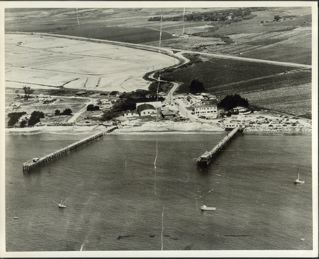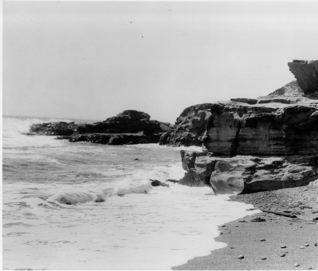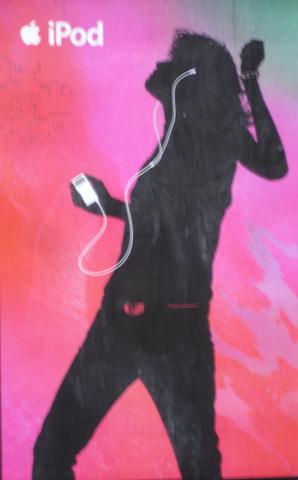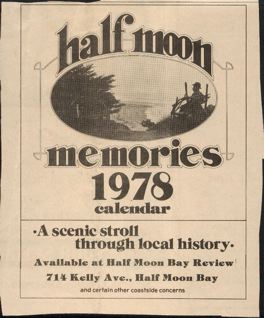great HBO watching
beginning with
Deadwood,
then
the plucky Entourage, followed by
the absolutely vulgar Lucky Louie
and we top the night
off with the scary
Brotherhood on Showtime
where every week angelic looking good brother Tommy Caffee’s devastatingly handsome Robert De Niro lookalike evil brother Michael beats up or kills somebody: (when are the cops going to arrest Mike and get him off the streets?–well the writers won’t let that happen because Tommy and Mike may be brothers but they are also two parts of a whole)
When Rumrunners Ruled (Part 4)
âWe not only learned enough to uncover one of the biggest bootleg rings in the country,â? boasted Mobile Prohibition Supervisor John Exnicios, âbut we also have the names of all of the prominent members of the ring.â?
Leaked to the press was the news that Giovanni Patroni had revealed the identity of the Vancouver company that furnished the liquor, names of all the rumrunnerâs boats, and to whom the booze was consigned.
Under pressure, Patroni had fingered Tom Murphy.
When the authorities finally located him, Murphy admitted that he had contracted with a major bootlegging ring in Vancouver to carry contraband liquor from Canada to the San Mateo County Coatside, making deliveries in small fishing boats at Princeton.
Law enforcement and the judicial system were erratic during the Prohibition era. Despite Tom Murphyâs indictment and confession, he did not serve jail time but continued his bootlegging career with partner Paul Pane at Ano Nuevo.
By 1924, Prohibition Director Sam Rutterâs agents had become tougher and armed themselves with sawed-off shotguns. When Rutter learned 240 cases of Canadian Club whiskey were arriving at Ano Nuevo, he raided the South Coast ranch. But by then Pane and Murphy had vanished from the beach into the darkness and werenât found.
J.F. Steele was arrested but granted immunity for furnishing Rutter with evidence leading to the indictments of Pane and Murphy, according to newspaper accounts. Steeleâs life was threatened and he received protection from the authorities.
A year after the Ano Nuevo raid, Pane and Murphy had still not been found. Then, in a bizarre twist, the San Francisco Prohibition office received a report that Tom Murphy had barricaded himself in his apartment in the City. He was armed and vowing to resist arrest.
A squad of heavily armed federal officers surrounded Murphyâs residence but when they rushed the door the agents found the rum baron sitting quietly by a window counting $30,000 in cash. He submitted to arrest without protest but his trial would not begin until his partner Paul Pane was also in custody.
…to be continued…
When Rumrunners Ruled (Part 3)
Three years earlier, in 1921, Paul Pane and Tom Murphy began their bootlegging operations at Princeton-by-the-Sea, some four miles north of Half Moon Bay. With the collapse of the Ocean Shore Railroad, Princeton was a failed resort and some residents were ready for any kind of business.
Overlooking Princeton Bay for many years was the Patroni House, a seafood and Italian restaurant owned by Giovanni Patroni. Fishing boats docked at the nearby wharf, also called âPatroniâsâ?.
Born in Genoa, Italy in 1878, Giovanni, the son of farmers, learned the hotel business in San Francisco before moving to Princeton in the early 1900s. Patroni also formed a partnership with El Granada artichoke farmer Dante Dianda. Together they owned 400 acres.
In 1921 when Patroni was 43-years-old, bootlegger Thomas Murphy approached the restaurant owner, convincing him to let his wharf be used to unload illegal liquor.
A few months later, in the fall, fishing boats delivered $60,000 worth of illegal whiskey from Vancouver to Patroniâs Wharf. Tipped off about the shipment, agents led by Mobile Prohibition Supervisor John Exnicios raided the Patroni House, confiscating thousands of dollars of bonded liquor.
Arrested for violating the Volstead (Prohibiton) Act, Giovanni Patroni confessed that he was a member of a bootlegging ring smuggling thousands of dollars worth of high-grade whiskey into Princeton. Patroni was released on bond in return for testifying before the grand jury he received immunity.
The information Exnicios extracted from Patroni made him optimistic that booze smuggling on the San Mateo County Coastside had been smashed.
â¦to be continuedâ¦
(Photo: San Mateo County History Museum. Visit the museum at the historic Redwood City Courthouse)
I Visit The Old Victorian: A Most Creative Miniature Shop
Stopped by to see Marilyn Haupert at the “Old Victorian Miniature Shop”, 799 Main Street, Half Moon Bay.
Marilyn’s been in the miniature business for eight years (before that she was a very successful realtor for 35 years)– and now she’s having a terrific sale– she’s going to close the store and kick back a little.
She’s an expert on miniatures and the store has a little bit of everything small (I bought a mermaid)–it’s heaven if you enjoy the smaller things in life like tiny upholestered gold & red striped couches and chairs, old-fashioned pinty-pint-sized claw-footed bathtubs, beautifully made itty bitty dolls…
There’s much to look at and enjoy and Marilyn is charming and knowledgable. She also told me that as a realtor she bought copies of my book, “Half Moon Bay Memories”, to give to clients as gifts…..
Flowers At Farmer’s Market, Half Moon Bay
When Rumrunners Ruled (Part 2)
It was dark and the bootlegger Paul Pane was standing with his men on an isolated beach near Ano Nuevo. His job was to signal the Canadian vessel, Prince Albert, with a flashlight, using a special code to give the all clear signâallowing the skiffs aboard the rumrunner to sail through the surf with cases of illegal booze destined for Half Moon Bay and San Francisco.
But the night didnât feel right. Pane sensed something was wrong; even some of his men were acting peculiarly. For whatever reason, Pane and his partner, Tom Murphy, the last of the old line of bootleggers, smelled serious trouble at Ano Nuevo in 1924.
Without apparent warning, the pair bolted, leaving so fast that Pane abandoned his suit jacket with the secret code book still inside. Pane and Murphy escaped to Santa Cruz. They had little choice as the Half Moon Bay Road, present day Highway 92, was closed for repairs.
Paneâs instincts were on target. Minutes after the two rum barons departed from Ano Nuevo, armed men raided the South Coast smuggling operation, a seaside ranch belonging to J.F. Steele. (Steele had been âconvincedâ? into cooperating with the bootleggers). Embarrassed and frightened, Steele was arrested, then released on his own recognizance. Other men were also arrested, two of them Pane-Murphy gang members who were later killed in a shootout with hijackers in Los Angeles. Also taken into custody was Steeleâs employee, Teamster Joseph Soto.
Collecting evidence at the crime scene, Prohibition Director Rutter gathered bottles of the Canadian Club whiskey for testing by the governmentâs chemical analyst. Rutter also took into evidence Paul Paneâs coat jacket with the bootleggerâs name stitched inside. Reaching into that coat pocked, Rutter pulled out the prized secret signal code book. Flipping through it, he realized he had the key to all the bootleggerâs flashlight codes: wait; delay all clear; danger; get out; return tomorrow; return to San Francisco; return to ship; and go to Santa Cruz.
Paul Pane and Thomas Murphy were declared fugitives from justice for violating the Volstead [Prohibition] Act. A manhunt for them in the Santa Cruz Mountains turned up nothing. Pane and Murphy had escaped, perhaps as far north as Canada.
—to be continued–
I Meet “Farmer John”
Today I was down at the wonderful wholesale flower place on Hwy 1–the one with yards and yards of orchids and indoor and outdoor plants and flowers and, oh gosh, everything that’s green and pink and red and yellow and multi-colored and I better stop because I’ll want to buy everything and then so will you…
I walked outside into the parking lot, loaded down with my flowerful treasures, when I saw these luscious, blood-red, deep deep red, Dahlias. Full and fluffy and well-fed flowers that were so dressed up they looked like they were going out dancing…They were waiting patiently in the back of an open van.
Several buckets were filled with these long-legged, freshly cut lusty red Dahlias–and I sighed, biting my lip, wishing I could go back inside and buy a bunch…They’d look so good in my house…
Instead I met the man who belonged with the gorgeous Dahlias, or vice versa… I was with a friend who told me, “That’s Farmer John. He’s political, he’s well known around town.”
I remembered Farmer John’s political signs on Hwy 92…I was thinking, “What did he run for?” Then I said it out loud.
“I’m on the City Council,” he told me gravely.
I noticed he was wearing overalls, a farmer, the real thing.
He asked my name. I told him and there was a glint of recognition in his eyes.
“The artist,” he said.
Wow, I thought—now I’m an “artist”–that’s a step up from carrying the moniker “local historian” for so many years.
Back to the Dahlias.
“I just picked them,” Farmer John said, explaining that he delivered flowers to the nursery every week.
The subject then turned from flowers to Half Moon Bay and Farmer John said, “All the travel writers are coming here now. Half Moon Bay’s the ‘in’ place.”
He also told me that he gives “around the bonfire talks” to corporate groups, stories of his adventures in San Gregorio & Pescadero–and other historical stuff that’s been passed down to him over the past 60 years, sometimes with a little hyperbole thrown in.
Farmer John’s blooms can be admired and bought at Half Moon Bay’s Farmer’s Market–
Two Degrees Of Separation
Did you ever wonder if the silhouettes that advertised IPODS on Bay Area billboards were real people–and if they were real, who are they?
I can now reveal that the silhouettes ARE real people.
Recently I had lunch with friends whose beautiful young daughter, Christiana, told me that her friend from New York, Martin, is one of the silhouettes. (See Martin below).
Christiana told me that Martin is a model, an outstanding dresser with extraordinary looks who was “discovered” walking down the street in New York City–and signed up for Apple’s IPOD advertising campaign.
So, what does that make me? Two degrees of separation from Martin?
When Rumrummers Ruled (Part I)
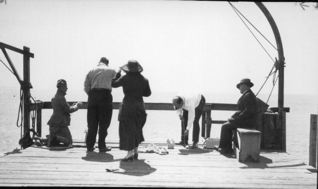 (Photo: The pier at Princeton-by-the-Sea)
(Photo: The pier at Princeton-by-the-Sea)
When the San Mateo County Coastside was identified as a major depot of smuggled Canadian whiskey during Prohibition., pioneer liquor buccaneers Paul Rubio Pane and Thomas Murphy called themselves exporters—but they were hardened professional bootleggers who needed the cooperation of locals to unload hundreds of cases of illegal booze on isolated Half Moon Bay and Pescadero beaches.
Destined for thirsty customers in San Francisco, the whiskey earned Pane, Murphy and their rum-running masters huge profits.
By 1924 Paul Pane and Thomas Murphy had been using South Coast farmer J.F. Steele’s Ano Nuevo seaside ranch as their home base for more than a year. They often ate breakfast at Steele’s place south of the Pigeon Point lighthouse and might have passed as locals. But they took their orders from the notorious Joe Parente. Headquartered in Vancouver, British Columbia, Parente was the king of all the Pacific Coast rumrunners.
After convincing Steele to collaborate with them, Pane and Murphy established a routine. Electricity had not yet reached the Pescadero on the South Coast—and in the evening the road was eerily dark.
Pane and Murphy supervised the nighttime loading of 100 proof-plus Canadian Club whiskey onto trucks—liquor delivered secretly to a secluded beach cove by two small skiffs.
The operation went smoothly until the spring of 1924. As 240 cases of illicit whiskey were being loaded onto trucks, Paul Pane’s sixth sense alerted him to trouble—and trouble usually meant the police. He even felt suspicious of his partner Thomas Murphy, the co-owner of the Prince Albert, a vessel registered in British Colombia.
As usual the Prince Albert’s final port of call was Ensenada, Mexico. Unless witnesses to a crime, the Coast Guard did not board vessels headed for ports outside of the United States. Packed with a full load of whiskey, the Prince Albert sailed south from Vancouver along the Pacific Coast, carefully observing the 3-mile limit near Steele’s Ano Nuevo ranch.
From his position on the beach, Paul Pane, using his secret code-book, signaled the Prince Albert with a flashlight, advising the vessel that it was all clear. A high-powered motorboat rendezvoused with the Prince Albert, taking on board the cases of liquor. From the motorboat, the cargo was transferred again to small skiffs that sailed through the surf and onto the cliff-lined beach. With the loud pounding of waves drowning out conversation, Pane stowed his flashlight, automatically slipping the secret code-book into his coat pocket.
—To be continued–

